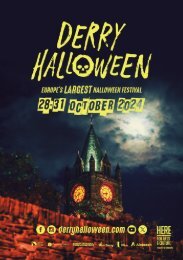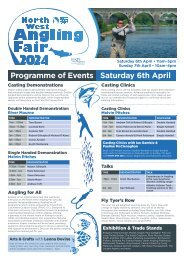The Thundering Guns of Derry
You also want an ePaper? Increase the reach of your titles
YUMPU automatically turns print PDFs into web optimized ePapers that Google loves.
<strong>The</strong><br />
<strong>Thundering</strong><br />
<strong>Guns</strong><br />
<strong>of</strong><br />
<strong>Derry</strong><br />
“ the great guns, like thunder,<br />
have shaken our walls”<br />
Rev. Seth Whittle, London-<strong>Derry</strong>, 1689
Are you a<br />
cannon<br />
expert?<br />
“ All our great pieces<br />
<strong>of</strong> one name are not<br />
<strong>of</strong> one length nor <strong>of</strong><br />
one weight, nor <strong>of</strong><br />
one height in their<br />
mouths”<br />
Blackmore 1977, 391<br />
quoted in the Tartaglio’s<br />
Arte <strong>of</strong> Shooting 1588<br />
Did You<br />
Know?<br />
<strong>The</strong> longest cannon on<br />
the <strong>Derry</strong> Walls are just<br />
over 3 metres.
In over 400 years the cannon<br />
on the <strong>Derry</strong> Walls have<br />
not moved from the place<br />
they were commissioned<br />
for and represent the finest<br />
collection <strong>of</strong> cannon <strong>of</strong> their<br />
period in Ireland or Britain.<br />
<strong>The</strong> <strong>Derry</strong> Walls with their<br />
bastions and ramparts<br />
were designed in the early<br />
1600s to accommodate the<br />
cannon.<br />
Each <strong>of</strong> the guns tells us<br />
about the history <strong>of</strong> the<br />
defence <strong>of</strong> the City and is<br />
a unique record <strong>of</strong> 16 th and<br />
17 th century metalwork.<br />
<strong>The</strong>y can also tell us much<br />
about the skills <strong>of</strong> the<br />
people employed to fire and<br />
maintain them.<br />
<strong>The</strong> oldest cannon on<br />
the <strong>Derry</strong> Walls are two<br />
Tudor period cannon, both<br />
marked with rose-andcrown<br />
emblems. <strong>The</strong>se<br />
cannon are mounted on<br />
replica block carriages. <strong>The</strong><br />
wheels at the front allowed<br />
the cannon to be moved<br />
and a solid block <strong>of</strong> wood at<br />
the rear acted as a brake to<br />
curtail recoil.
In the 1620s the Corporation<br />
in London sent over<br />
ten cannon complete<br />
with carriages, shot and<br />
equipment. You can still see<br />
five <strong>of</strong> these on the Walls,<br />
emblazoned with the City <strong>of</strong><br />
London shield and mounted<br />
on replica block carriages.<br />
Did You<br />
Know?<br />
<strong>The</strong> heaviest cannon on<br />
the <strong>Derry</strong> Walls is a<br />
Merchant Taylor<br />
Company gun, weighing<br />
1,830 kilograms.
<strong>The</strong> most impressive<br />
cannon are the seven<br />
London Company cannon,<br />
mounted on the large<br />
replica field carriages and<br />
located on the bastions.<br />
<strong>The</strong>se were among a<br />
batch <strong>of</strong> fifteen sent here<br />
in 1642. Each <strong>of</strong> their<br />
barrels had been inscribed<br />
with the name <strong>of</strong> the<br />
London Company that<br />
commissioned them.<br />
Did You<br />
Know?<br />
Gunner’s Bastion was so named<br />
because it once stood opposite the house<br />
<strong>of</strong> the Master Gunner. <strong>The</strong> bastion has<br />
since been demolished and the site sits<br />
next to Butcher Gate at the top<br />
<strong>of</strong> Waterloo Street.
<strong>Thundering</strong> <strong>Guns</strong><br />
<strong>The</strong> <strong>Guns</strong> on the <strong>Derry</strong> Walls were brought over in the<br />
17th Century, either in 1622 as part <strong>of</strong> the plantation<br />
or in 1642 from the City <strong>of</strong> London for the defence <strong>of</strong><br />
the City. <strong>The</strong>y have remained an important feature on<br />
the Walls ever since.<br />
19th Century Cannon<br />
City <strong>of</strong> London Cannon<br />
Fishmongers and<br />
Vintners Company<br />
Cannon<br />
Merchant Taylors Company<br />
Cannon
<strong>of</strong> <strong>Derry</strong> Locations<br />
City <strong>of</strong> London Cannon<br />
Tudor Cannon<br />
Grocers and Mercers<br />
Company Cannon<br />
City <strong>of</strong> London and Salters<br />
Company Cannon
Did You<br />
Know?<br />
To fire a cannon, a length <strong>of</strong> slowburning<br />
cord, impregnated with<br />
saltpetre, was held at the end <strong>of</strong> a very<br />
long stick. <strong>The</strong> stick was called a linstock<br />
and helped put distance between the<br />
gunner and his cannon.<br />
Cannon<br />
in<br />
action
Even with a carriage,<br />
powder, shot and all the<br />
accessories, cannon were<br />
ineffective unless operated<br />
by skilled gun crews. It<br />
could take up to six men<br />
to fire a large cannon. Two<br />
packed the gunpowder into<br />
the barrel and inserted the<br />
cannon ball. A third lit the<br />
fuse while a fourth aimed<br />
the cannon at the target.<br />
<strong>The</strong> force <strong>of</strong> the explosion<br />
could cause the gun<br />
carriage to roll back up to<br />
six metres. <strong>The</strong> last two men<br />
pushed it back into position,<br />
ready to load again.<br />
Most shot (cannon balls)<br />
were solid, made from<br />
stone, cast iron or lead.<br />
Mortars shells were hollow<br />
spheres, usually made<br />
<strong>of</strong> cast iron, filled with<br />
gun powder. It was the<br />
mortars which caused most<br />
casualties and damage to<br />
buildings during the 1689<br />
siege.
Impress your<br />
descendants<br />
Knowing more about<br />
the <strong>Thundering</strong> <strong>Guns</strong><br />
<strong>of</strong> <strong>Derry</strong> will ensure<br />
their preservation for<br />
future generations.<br />
Did You<br />
Know?<br />
In the 1980’s when the bore <strong>of</strong> the<br />
Fishmongers Company cannon was<br />
cleaned out, the concreted contents<br />
included a cannon ball, a pottery<br />
beer bottle, a pocket watch and the<br />
skeleton <strong>of</strong> a rat.
From the 18th century<br />
onwards, a few continued to<br />
be fired during celebrations<br />
but most fell into disuse.<br />
Others were removed<br />
from the Walls, ending up<br />
as bollards on the street<br />
corners and along the quays<br />
for mooring ships. An 1837<br />
inventory noted 50 cannon;<br />
the fate <strong>of</strong> the missing ones<br />
are yet to be uncovered.<br />
Today the surviving cannon<br />
have a more peaceful role in<br />
ornamenting the bastions<br />
and ramparts <strong>of</strong> Ireland’s<br />
most famous Walled City.<br />
<strong>Derry</strong> City and Strabane<br />
District Council and the<br />
Friends <strong>of</strong> the <strong>Derry</strong> Walls<br />
are working together to<br />
restore the cannon on the<br />
City Walls, making them<br />
even more impressive for<br />
future generations.
<strong>The</strong><br />
<strong>Thundering</strong><br />
<strong>Guns</strong><br />
<strong>of</strong><br />
<strong>Derry</strong>

















